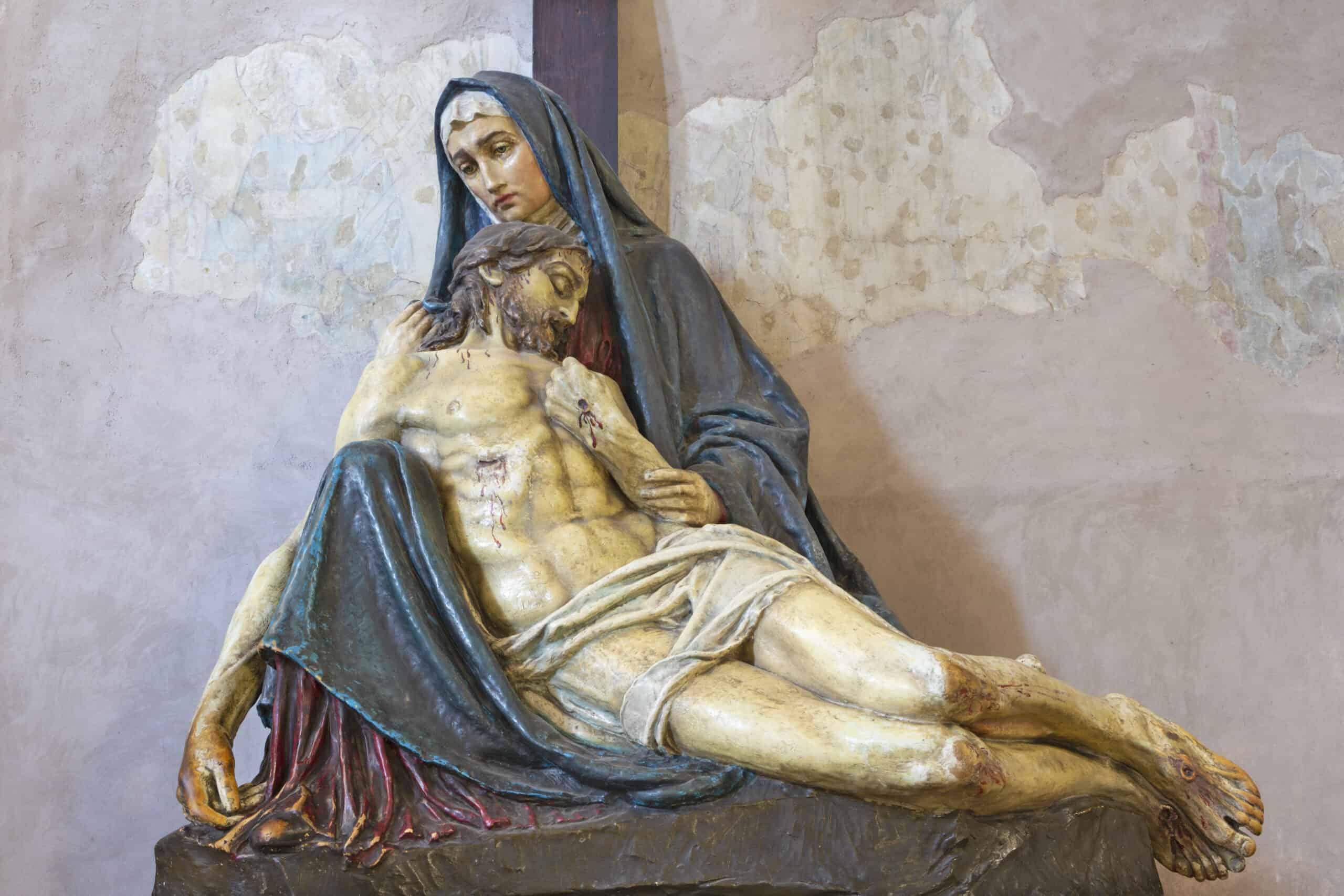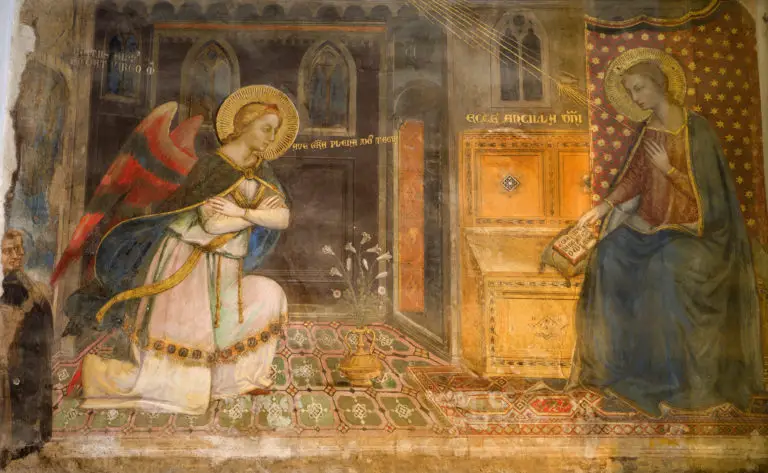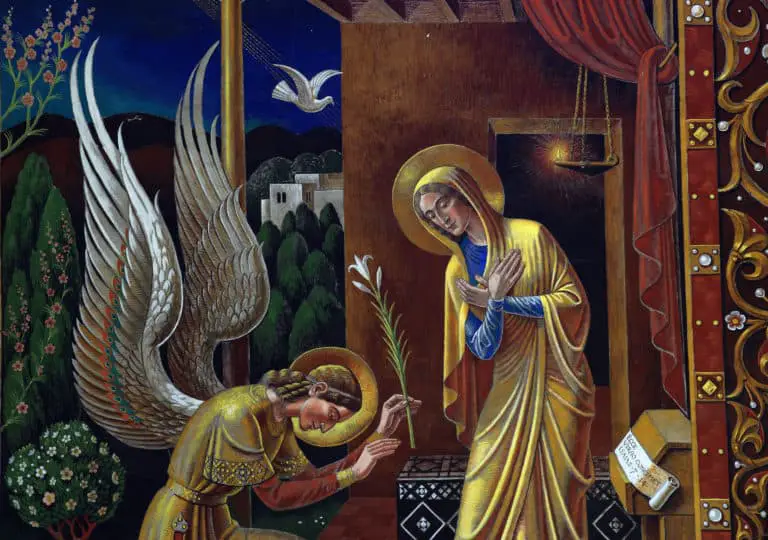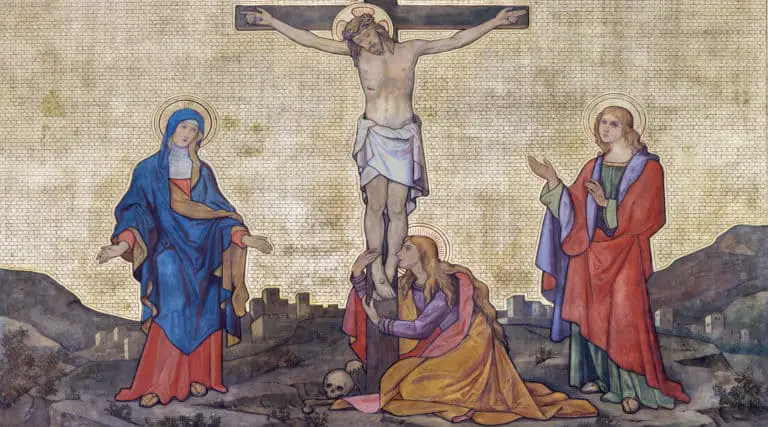Why do Catholics pray to Mary?
This question has been at the center of many discussions throughout the ages, often leading to misunderstandings about Catholic devotional practices. The tradition of seeking Mary’s intercession is not a modern invention but dates back to the earliest days of Christianity. In fact, a papyrus from 250 A.D. contains one of the first recorded prayers to the Blessed Mother.
Many have questioned whether Catholics pray to Mary instead of directly to Jesus, or why we would ask Mary to pray for us rather than approaching God directly. This practice is not about replacing Jesus as our one mediator but embracing the biblical concept of intercessory prayer. As we read in the Scriptures, St. Paul tells us that God grants blessings “in answer to many prayers” (2 Cor. 1:11). I find this particularly important to understand – the Catholic approach to prayer to Mary is fundamentally a request for her intercession, not worship, which we reserve for God alone.
The biblical foundation for this devotion is clearly visible in the wedding at Cana (John 2:1-11), where Mary brings the needs of others directly to Jesus, resulting in His first miracle. This pattern of maternal intercession explains why Catholics pray to Mother Mary – not because we worship her, but because we recognize her unique position as Jesus’s mother and the most righteous among humanity.
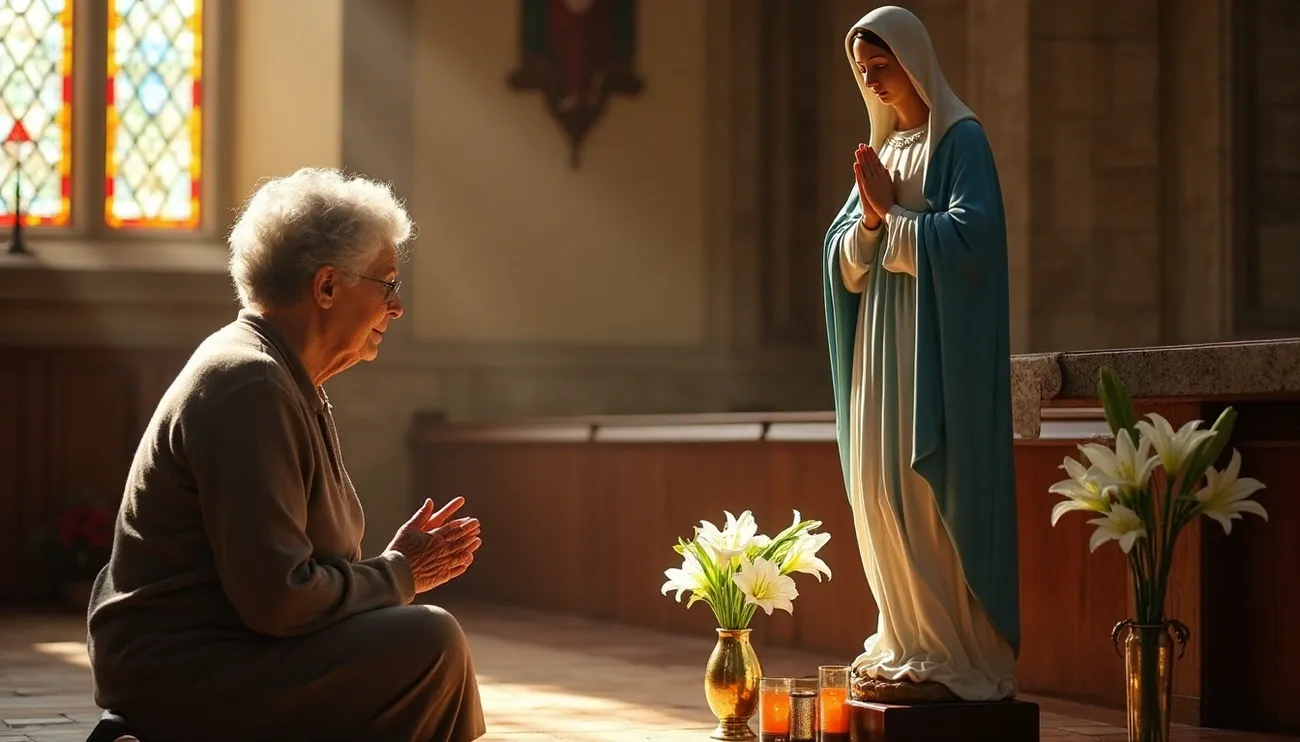
Throughout this article, I will explain five essential facts about Catholic devotion to Mary that will help clarify this often misunderstood practice. Let us consider how this devotion actually draws us closer to Christ rather than away from Him.
Fact 1. Catholics honor, not worship, Mary
One of the most common misconceptions about Catholic devotion to Mary stems from a fundamental misunderstanding: confusing honor with worship. Throughout the history of Christianity, Catholics have maintained a clear distinction between the veneration they show to Mary and the worship reserved for God alone.
What does it mean to pray to someone?
Prayer, in its essence, is not synonymous with worship. St. John Damascene teaches that prayer is simply “the raising of one’s mind and heart to God or the requesting of good things from God.” This definition reveals an important truth – prayer can be a form of communication that doesn’t necessarily include adoration.
The Catholic Church distinguishes between three different types of religious reverence:
Latria – This is true worship or adoration that is given to God alone
Dulia – This is veneration or honor given to saints
Hyperdulia – This is special veneration given specifically to Mary as the greatest of saints
When Catholics kneel before an image of Mary or speak prayers addressing her, they are practicing dulia (veneration), not latria (worship). As the Catechism teaches,
“The Church rightly honors the Blessed Virgin with special devotion,” while maintaining that “only God is to be adored and worshiped.”
This distinction is similar to how we might honor important people in society without worshiping them. In older English wedding ceremonies, spouses would say they “worship” each other with their bodies – clearly not meaning divine adoration but profound respect and honor.
Why Catholics pray to the Virgin Mary and not just to God?
Catholics pray to Mary primarily as an intercessor – someone who brings our petitions before God. Think of it as asking a friend to pray for you during difficult times. St. Paul himself encouraged Christians to pray for one another, writing that God grants blessings “in answer to many prayers” (2 Cor. 1:11).
What makes Mary’s intercession special?
Several factors contribute to this:
Her unique relationship with Jesus as His mother gives her prayers particular efficacy. At the wedding at Cana, Mary brought the needs of others directly to Jesus, resulting in His first miracle.
Mary is “full of grace” (Luke 1:28) and “blessed among women” (Luke 1:42), making her prayers especially powerful. As we read in the Scriptures, “The prayer of a righteous person has great power” (James 5:16).
Mary’s motherhood extends to all Christians. At the cross, Jesus gave Mary to the disciple John saying, “Behold your mother” (John 19:27), which Catholics understand as extending Mary’s motherhood to all believers.
I highly recommend considering the beautiful analogy provided by St. Louis de Montfort – like a peasant offering a gift to a king through the queen, who places it on a golden dish making it worthy of the king’s acceptance, so do our prayers reach Jesus through Mary.
Mary always points to Jesus, never to herself. Her last recorded words in Scripture are instructions to others: “Do whatever he tells you” (John 2:5). When Catholics pray to Mary, they’re ultimately seeking Jesus through His mother’s guidance and intercession.
Consider this, could Jesus have entered our world directly? Yes, of course He could have, yet He chose to enter our world through Mary. Therefore is it not right that we go to Jesus through Mary? Hence imitating God!
Fact 2. Intercessory Prayer is a Biblical Practice
Throughout the Scriptures, we find numerous examples of people praying for one another. This practice of intercessory prayer forms a cornerstone of our faith. Many wonder why Catholics pray to Mary when they could approach God directly. To understand this, we must examine the biblical foundation of intercessory prayer.
What is Intercessory Prayer?
Intercessory prayer is simply the act of praying on behalf of others. The word “intercessor” comes from Latin roots meaning “to go between” or “to mediate.” When we intercede, we stand in the gap between God and another person, bringing their needs before the Lord.
This differs from personal petitions in that intercessory prayer reflects selfless love—focusing on others’ spiritual and physical wellbeing rather than our own needs. The Catechism of the Catholic Church explains it as “a prayer of petition that leads us to pray as Jesus did.”
Christ Himself is the perfect intercessor. As we read in the Scriptures, Romans 8:34 reminds us, “Christ Jesus, who died—more than that, who was raised to life—is at the right hand of God and is also interceding for us.” Nevertheless, we participate in this ministry as an extension of Christ’s role.
Examples from Scripture: Praying for One Another
The Bible provides many examples of intercessory prayer:
Abraham interceded for Sodom, negotiating with God to spare the city if righteous people were found there (Genesis 18:22-25)
Moses prayed for Israel despite their rebellion, appealing to God’s mercy (Numbers 14:17-19)
Samuel assured the Israelites: “Far be it from me that I should sin against the Lord by failing to pray for you” (1 Samuel 12:23)
Paul repeatedly asked for prayers from churches he wrote to (Ephesians 6:19-20, Philippians 1:19)
Furthermore, Scripture explicitly commands believers to pray for one another. James 5:16 states, “Therefore confess your sins to each other and pray for each other so that you may be healed. The prayer of a righteous person is powerful and effective.”
Why Do Catholics Ask Mary to Pray for Them?
Catholics ask Mary to pray for them based on several biblical principles:
First, if the “prayer of a righteous person avails much” (James 5:16), then Mary—as the mother of Jesus and “full of grace” (Luke 1:28)—possesses extraordinary intercessory power.
Second, Mary’s unique relationship with Jesus makes her intercession particularly effective. At the wedding at Cana, Mary noticed the hosts’ need and brought it to Jesus’ attention, resulting in His first miracle—even though Jesus initially suggested His “hour had not yet come.”
Catholics understand that Mary’s intercession doesn’t replace Christ’s role as the one mediator between God and humanity. Instead, Mary—like all saints in heaven who are “made perfect” (Hebrews 12:23)—collaborates with Christ in interceding for us.
Many wonder why Catholics pray to Mother Mary when they could go directly to Jesus. The answer is similar to why we ask friends on earth to pray for us—because God grants blessings “in answer to many prayers” (2 Corinthians 1:11). Mary’s prayers, given her closeness to Christ, carry special efficacy.
This practice resembles approaching a king through the queen mother—a biblical concept seen in Solomon’s relationship with Bathsheba (1 Kings 2). Throughout salvation history, the mother of the king held a unique position of influence.
Therefore, Catholics ask Mary to pray for them not as a replacement for prayer to God, but as the most powerful human intercessor in the communion of saints.
Fact 3. Mary’s unique role in salvation history
Mary occupies a unique position in salvation history unlike any other human being. Her role extends far beyond biological motherhood, representing an extraordinary participation in God’s divine plan for our redemption. To understand why Catholics pray to Mary, we must first understand her pivotal role in salvation history.
I) Her ‘yes’ at the Annunciation (Her ‘fiat’)
The most critical moment in Mary’s life—and indeed, in all human history—occurred during the Annunciation. When the Angel Gabriel appeared to this young Jewish maiden with God’s extraordinary request, the fate of humanity hung in the balance. Unlike Eve, whose disobedience brought sin into the world, Mary’s free “yes” to God opened the door to our salvation.
“Behold, I am the handmaid of the Lord; let it be done to me according to your word” (Luke 1:38). This simple yet profound statement of consent allowed the Incarnation to take place. Through Mary’s cooperation with divine grace, God became man, entering human history not as a fully-formed adult but as a vulnerable infant, completely dependent on his mother.
Many of the Church Fathers refer to Mary as the “New Eve,” highlighting how her obedience counterbalanced the first woman’s disobedience. St. Irenaeus beautifully expressed that “the knot of Eve’s disobedience was untied by Mary’s obedience.” This shows that Mary’s willing participation was essential to God’s redemptive plan for humanity.
II) Mary as the Mother of God
The Catholic Church honors Mary with the title “Theotokos”—Mother of God—a title officially proclaimed at the Council of Ephesus in 431 AD. This title doesn’t suggest Mary created God but acknowledges that the child she bore was truly divine. Since Jesus is one person with two natures (human and divine), Mary is genuinely the mother of God incarnate.
This profound reality gives Mary an unparalleled closeness to Jesus. No other human shared such an intimate physical and spiritual bond with Christ—carrying Him in her womb, nursing Him as an infant, raising Him to adulthood, and standing by the cross as He died. As Catholics, we believe this unique relationship gives Mary’s prayers extraordinary power and efficacy.
Why do Catholics pray to Mother Mary?
Catholics pray to Mother Mary primarily because of her singular relationship with Jesus. Her proximity to Christ gives her prayers extraordinary power. Moreover, Mary’s perfect discipleship—her unwavering faith from Annunciation to Pentecost—makes her the model Christian for all believers.
Unlike the general concept of intercessory prayer discussed earlier, praying to Mary specifically acknowledges her unparalleled status in salvation history. Since God chose Mary as the vessel through which salvation entered the world, Catholics trust her as a powerful advocate who understands human needs with a mother’s heart.
Additionally, as Jesus’s first and most perfect disciple, Mary shows us how to follow Christ faithfully. By praying to her, Catholics seek not just her intercession but also her example of discipleship. I highly recommend contemplating the “Fiat” of Mary and how her complete surrender to God’s will serves as a model for our own relationship with the Lord.
The Catholic devotion to Mary is ultimately Christocentric—it leads us to her Son. Throughout the history of the Church, those with the strongest devotion to Mary have invariably been those with the strongest devotion to Jesus Christ.
Fact 4. Biblical support for Marian intercession
The Catholic practice of seeking Mary’s intercession is firmly rooted in Scripture. Throughout the Bible, we find clear indications of Mary’s unique relationship with Jesus and her role in the Church. Let us consider what the Scriptures say about Mary’s intercessory role, which helps explain why Catholics pray to Mary.
I) Wedding at Cana: Mary’s intercession in action
The most compelling biblical example of Mary’s intercessory power is found in John’s Gospel at the Wedding at Cana (John 2:1-11). In this significant moment, Mary notices the hosts have run out of wine and brings this need directly to Jesus. His initial response—”Woman, what have you to do with me? My hour has not yet come” (John 2:4)—might suggest reluctance. Yet remarkably, Jesus performs the miracle, turning water into wine.
This passage reveals two crucial aspects of Marian intercession:
Jesus granted Mary’s request even though He indicated it wasn’t yet time for His public ministry to begin.
Mary’s instruction to the servants—”Do whatever he tells you” (John 2:5)—represents her last recorded words in Scripture, forever directing humanity toward her Son.
This shows the extent of Mary’s influence with her Son and her desire to lead others to Him rather than to herself.
II) Revelation 12 and the woman clothed with the sun
In the Book of Revelation, we read about “a woman clothed with the sun, with the moon under her feet, and on her head a crown of twelve stars” who gives birth to “a male child, destined to rule all nations” (Revelation 12:1-5). Catholic tradition recognizes multiple layers of meaning in this imagery—the woman represents both Mary individually and the Church collectively.
The connection between this woman and Mary becomes clearer as the passage unfolds:
It describes the birth of a male child “caught up to God and his throne”—clearly referring to Jesus
Revelation 11:19 mentions the Ark of the Covenant appearing in heaven immediately before introducing this woman
This creates a symbolic link between Mary and the Old Testament Ark that carried God’s presence
As we have seen in the Scriptures, the Ark of the Old Covenant contained the manna, Aaron’s rod, and the tablets of the Law. Mary, as the Ark of the New Covenant, carried Jesus—the living bread from heaven, the true High Priest, and the fulfillment of the Law.
III) John 19: Jesus gives Mary to the Church
At the crucifixion, one of Jesus’ final acts was entrusting Mary to the apostle John: “Woman, behold your son” and to John, “Behold your mother” (John 19:26-27). This moment transcends a simple arrangement for Mary’s care after Jesus’ death.
What makes this significant?
Jesus did not entrust Mary to His biological brothers—who weren’t present at the crucifixion and didn’t yet believe in Him (John 7:5). Instead, He gave her to “the disciple whom He loved,” establishing a spiritual relationship. Catholics understand this as Jesus giving Mary as spiritual mother to all believers.
This is consistent with the ancient Christian understanding that John represented all faithful disciples at the foot of the cross. Through him, Jesus established a mother-child relationship between Mary and all who follow Him, further explaining why Catholics pray to Mother Mary—because Jesus himself established this relationship between His mother and His followers.
To understand how this would take place is to draw upon both Scripture and Tradition, providing a complete picture of Mary’s role in God’s plan of salvation.
Fact 5. The spiritual benefits of praying to Mary
Beyond theological discussions, praying to Mary offers Catholics profound spiritual benefits that enrich their journey of faith. Those who develop a relationship with the Blessed Mother often find their spiritual lives transformed in ways they never expected.
I) Mary leads us closer to Jesus
Mary’s purpose has always been to direct us toward her Son. Her last recorded words in Scripture remain “Do whatever he tells you” (John 2:5). Much like a mother who guides her child’s first steps, Mary takes believers by the hand and leads them to Jesus.
This reality counters the common misconception that Marian devotion somehow distracts from Christ. Mary serves as our spiritual compass, consistently pointing toward Jesus rather than to herself. Pope Francis affirms this truth when he says, “Our Lady never points to herself; she points to Jesus, and that’s what Marian piety is”.
A helpful comparison is to consider meeting a girlfriend’s family – growing to love her parents and siblings typically deepens rather than diminishes your love for her. Similarly, coming to know and love Mary only enhances our relationship with her Son.
II) She understands human suffering
Mary experienced profound suffering throughout her earthly life. From Simeon’s prophecy that “a sword will pierce your soul” to witnessing her beloved Son’s crucifixion, Mary endured sorrows that most of us cannot imagine. Through these trials, she “embodies unwavering faith, showing how resilience and trust in God can overcome the most painful trials”.
Her unique position as both perfect disciple and suffering mother makes her exceptionally qualified to understand our pain and sorrows. “Mary gives us this great example of how to go through human suffering,” offering not merely sympathy but genuine empathy rooted in personal experience. The depth of her suffering directly corresponds to the depth of her love – she suffered intensely precisely because she loved so deeply.
III) How Marian prayer deepens faith?
Marian prayer serves as a powerful tool for spiritual growth. Many Catholics testify that “after starting to pray the Rosary every day,” their “spiritual growth skyrocketed”. This occurs because Mary “transforms hearts” through her powerful intercession.
Simple devotional practices can have profound effects:
Placing an image of Mary in your home as a reminder of her presence
Praying the Angelus at noon, an ancient tradition honoring the Incarnation
Carrying a rosary with you throughout your day
Consecrating yourself to Jesus through Mary
These simple acts can dramatically impact one’s relationship with Christ. Above all, Mary becomes a spiritual mother who helps believers “become holy” by encouraging faithful obedience to her Son.
Catholics pray to Mary not because she replaces Jesus, but because she offers unique spiritual benefits as our heavenly mother – leading us closer to Christ, understanding our suffering, and deepening our faith through her powerful intercession.
Recommended Marian Devotional Practices:
The Holy Rosary
The Angelus Prayer
Consecration to Jesus through Mary
Marian Feast Day Celebrations
FAQs
Q1. Is praying to Mary the same as worshiping her? No, Catholics do not worship Mary. They honor her and ask for her intercession, believing she can pray to God on their behalf. This practice, called veneration, is distinct from the worship reserved for God alone.
Q2. Why do Catholics pray to Mary instead of directly to God? Catholics pray to Mary as an intercessor, not as a replacement for God. They believe Mary’s unique relationship with Jesus makes her prayers particularly effective. However, Catholics also pray directly to God and see Mary as a way to draw closer to Christ.
Q3. What is the biblical basis for Marian devotion? The biblical foundation for Marian devotion includes the Annunciation, where Mary says “yes” to God’s plan, and the wedding at Cana, where Jesus performs his first miracle at Mary’s request. Catholics also point to Jesus entrusting Mary to the disciple John at the crucifixion as establishing her motherhood for all believers.
Q4. How does praying to Mary benefit one’s spiritual life? Praying to Mary can deepen one’s faith by providing a model of perfect discipleship. Many Catholics find that Mary’s maternal intercession helps them grow closer to Jesus. Her experience of human suffering also allows her to empathize with our struggles and guide us toward Christ.
Q5. Is the practice of praying to Mary a recent development in Christianity? No, the practice of seeking Mary’s intercession dates back to the early Church. Historical evidence shows prayers to Mary as early as the 3rd century, with formal recognition of her role growing over time. The theological understanding of Mary’s intercessory role has developed throughout Church history.
